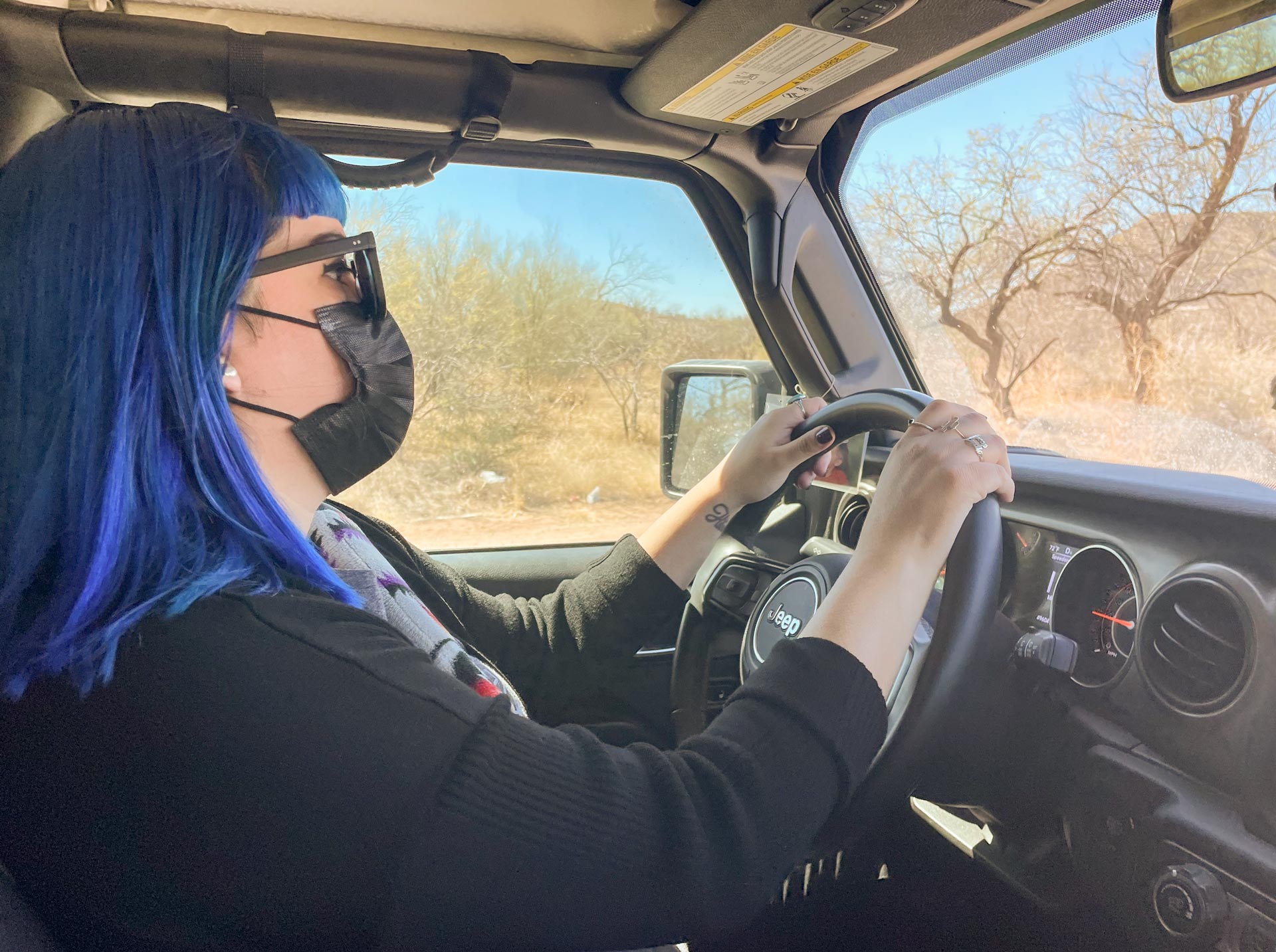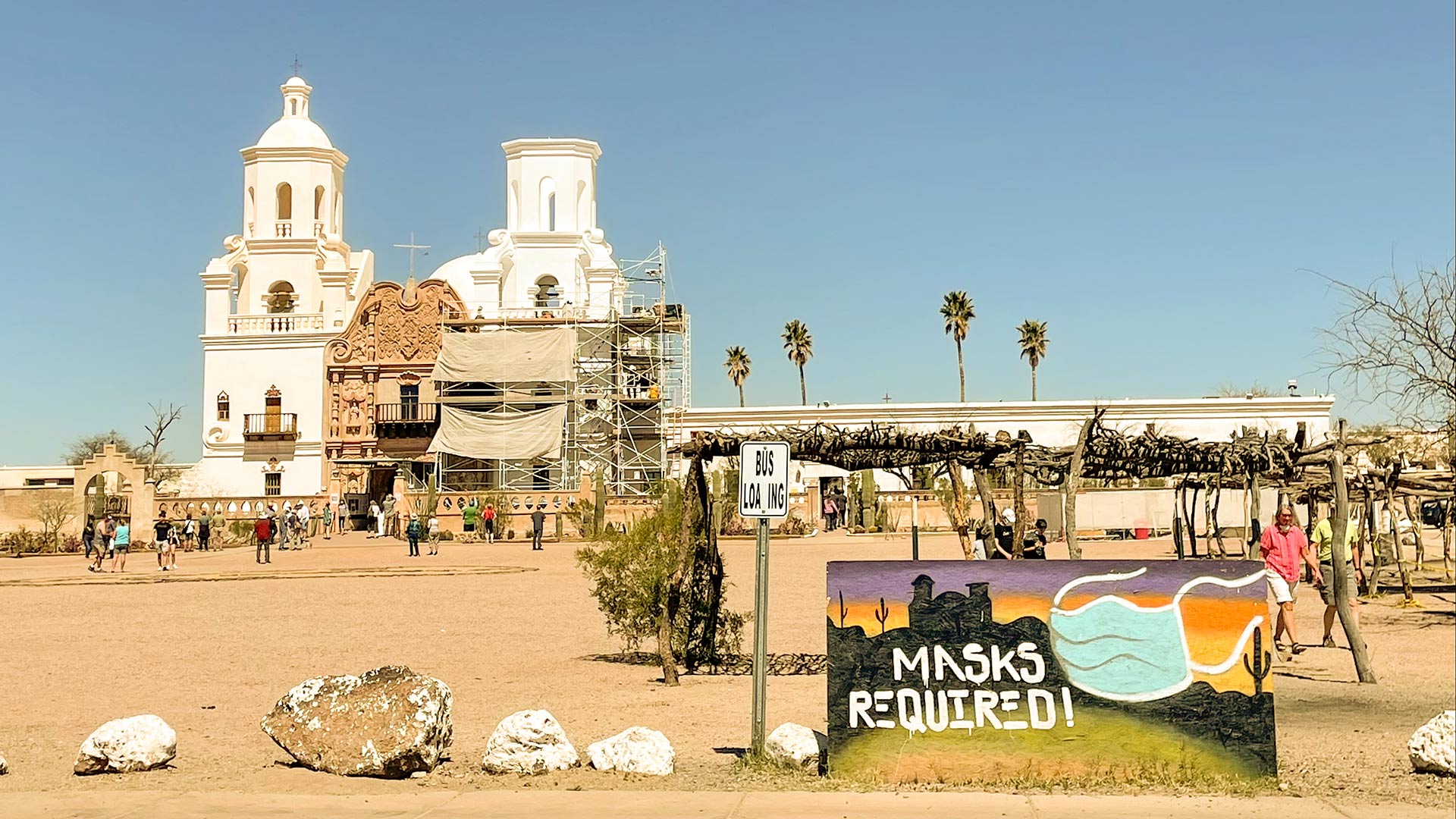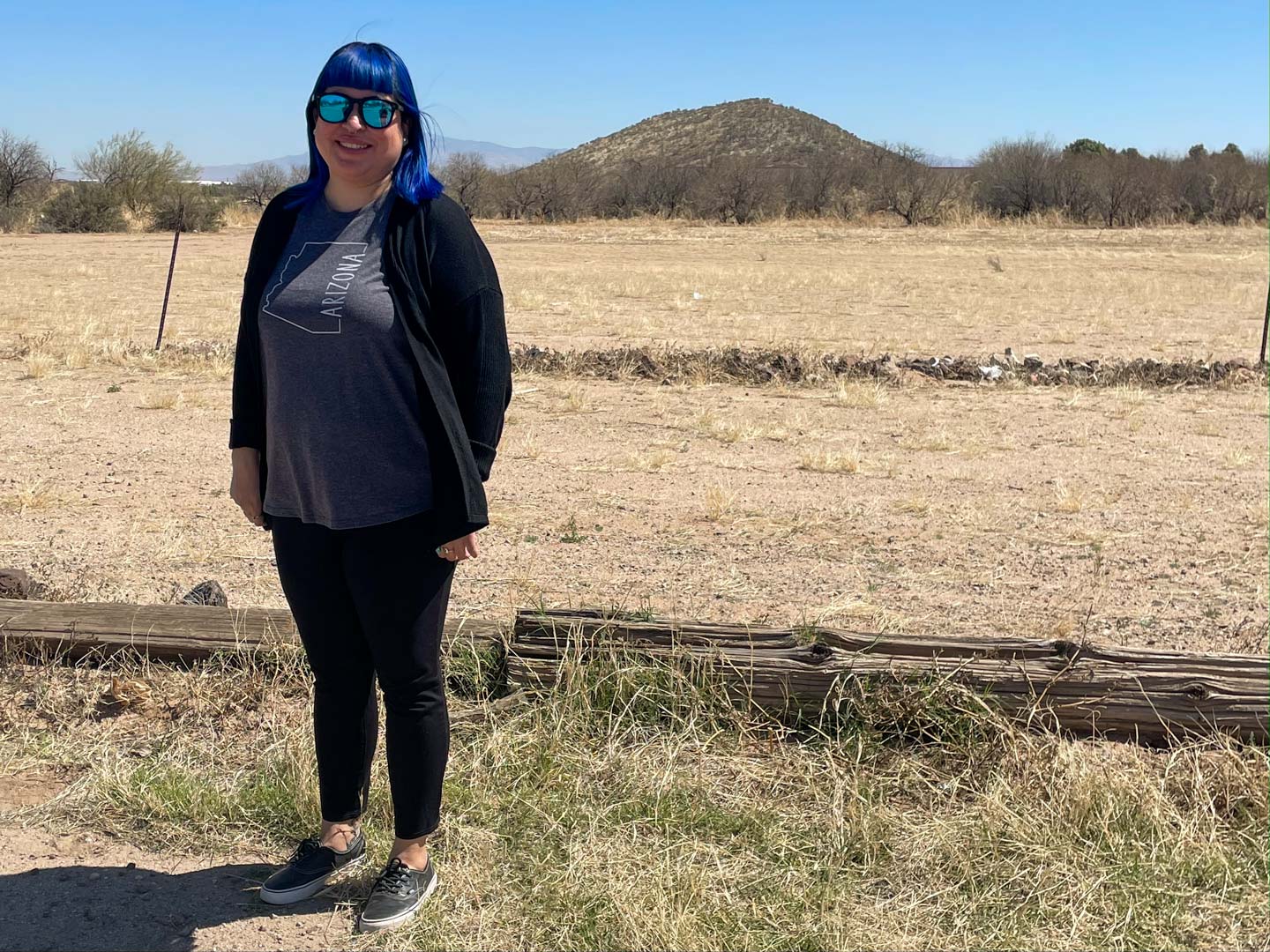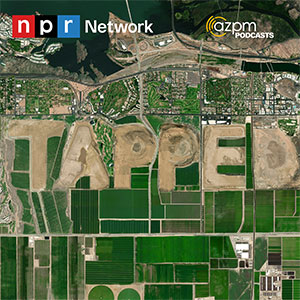Wa:k–where the water goes in

I met Jacelle Ramon-Sauberan on a late morning in March in front of the San Xavier del Bac Mission. We were standing in direct Arizona sun, water bottles in hand. Tourists crossed the parking lot near us in shorts and big, floppy hats.
“It gets hot here,” Ramon-Sauberan said. “And you have to be smart about living in the desert because otherwise you're not gonna survive.”
She’s a doctoral candidate, and was wrapping up a dissertation on the history of land and water here on the San Xavier Indian Reservation, part of the Tohono O’odham Nation. It’s a stone’s throw from Tucson–about a 20 minute drive from downtown–but it feels farther and a bit more rural.
For centuries, the Huhugam and then Tohono O'odham created systems to get water where they needed it while still accounting for desert scarcity. Those systems took serious hits as white settlers arrived and built Tucson.
Now, members of the Tohono O’odham Nation are reincorporating traditional knowledge and land management approaches around water. And they’re seeing results.
 VIEW LARGER Jacelle Ramon-Sauberan drives me around the San Xavier Indian Reservation. She’s writing a dissertation about the history of land and water there.
VIEW LARGER Jacelle Ramon-Sauberan drives me around the San Xavier Indian Reservation. She’s writing a dissertation about the history of land and water there.
Ramon-Sauberan is a member of the Tohono O'odham Nation.
“This is where I come from. This is my community,” she said.
It houses many land allotments, mostly farms, which has been the case for a long time.
“We’ve been farmers for time immemorial, in San Xavier, and we learned from our ancestors – the Huhugam – on how to farm,” she said.
The Huhugam lived across Southern Arizona from 200 AD until about the mid-1400s, about 90 years before the Spanish made it here. The Tohono O’odham are their descendants. They were close to rivers like the Salt and Gila, and here along the Santa Cruz. And those rivers were important.
They used to flow wide, especially after a big rain, and farmers could take advantage of that breadth of the river. And about 1,000 years ago, that led the Huhugam to build out systems to channel the water.
“Our ancestors created these intricate, very sophisticated canal systems,” Ramon-Sauberan said.
In their time, this was the most extensive and complex system in what we now call North America.
These canals were designed to bring water to farms for flood irrigation. And those farms were managed collectively, not split up by owner.
“The O’odham word for San Xavier is Wa:k, W-A colon K. And it means where the water goes in … a long time ago, in the river by the basin, they discovered that water would essentially disappear, and then it would come up somewhere else. And that was the aquifer,” Ramon-Sauberan said.
The Huhugam and then the Tohono O’odham knew and still know well how the water in this area worked. There’s not a lot of it, and there never has been. But, you can make a little go a long way.
Ramon-Sauberan said only taking what you need is not only a big part of their farming life, but also a big part of their culture.
“You got to think about other people, first of all, but also plants and animals and others that need that resource as well,” she said.
We don’t know exactly what happened to the Huhugam, though there are theories that involve drought, disease, migration. And the Tohono O’odham have traditional stories reserved for tribal members.
The way the Huhugam managed water in the area lived on with their descendants.
“A lot of times history books get it wrong,” Ramon-Sauberan said. “They make it seem as if Native people, specifically O’odham, didn't know how to live, and then the Spaniards came and taught us everything we know. And that's not true at all.“
Eusebio Kino was a Jesuit priest who first came to the area from Europe in the late 1600s.
“We've been living here for time immemorial,” Ramon-Sauberan said. “And when the Spaniards came over, when Father Kino came, they didn't know how to live in the desert. A lot of it was us teaching them.
Yes, they introduced new things to us, like cattle and horses and metal tools. But, again, we knew what grew here. We knew how to live off of the land.”
Father Kino founded the San Xavier del Bac Mission in 1700.
“He came here with good intentions and a good heart,” Ramon-Sauberan said. “I think sometimes people think it was only bad with Spaniards, and it wasn't at first.”
She said many Tohono O’odham felt what he preached about land stewardship and kindness to others meshed well with their own beliefs.
 San Xavier del Bac Mission, which was founded by Father Kino in 1700.
San Xavier del Bac Mission, which was founded by Father Kino in 1700.
Around the corner from the mission is the office of Cie’na Schlaefli, who monitors water levels and erosion across the San Xavier District. She also helps plan for floodwaters.
I met her at her favorite place to eat lunch–a balcony attached to her office building.
“You can see the mountains in the background, the Tucson Mountains. You can see the Catalinas, the Rincon Mountains,” Schlaefli said.
From this perch, we could see pretty far across the district. We had maps in front of us, but we almost didn’t need them. She explained what all we were looking at to me.
“They're the O’odham peas that they grow every winter. They're yellow now because they're drying out. They're going to be harvesting them soon,” she said.
She said part of Father Kino’s legacy is getting the word out about Tucson to other Spanish settlers. He thought there was enough water here that it could potentially become a metropolis, like Mexico City.
She said while this area might have looked lush to other desert dwellers, it really wasn’t.
“God, I would compare that to Cities of Gold,” Schlaefli said. “And then it encourages a lot more people to end up moving here.”
The promise of water brought more settlers and with more settlers came more government. By the late 1800s, the U.S. government signed the Dawes Act into law to break up tribal lands and give portions of it to homesteaders.
It was also designed to force Native Americans to assimilate, by offering them allotments of land to farm if they agreed to the arrangement. The government ultimately gave the Tohono O’odham smaller cuts of the land they already lived on.
And the land allotments went to families, not communities.
On a map, Schlaefli pointed out the allotments, all of which were along the river.
“It's where the water is, where the resources are, the mining operation that's south of there,” she said. “So, there was strategy around trying to take this land in this particular spot because this is where geologically, there's volcanic rocks underground, and the water gets held back.”
Again, the Tohono O’odham knew how to manage water in the desert. The settlers used water like they had in the greener places they’d come from, not recognizing it as finite.
“You had people start putting reservoirs on the river downstream, and cutting deeper ditches,” Schlaefli said. “Folks created these ditches, and then when big monsoons came, it just cut that spill all the way back.”
She explained what happened in a picture of a 30-foot drop of topsoil that was lost to the river. It’s a dusty wall that almost looks like the side of a canyon, with brittle rocks of all sizes lining it, as if they just fell off.
“When that happens, the water table drops, right because what now water can't be held in this soil,” she said.
Settlers kept digging wells and introduced water intensive crops, like pecans.
“There wasn't enough groundwater to come to the surface in San Xavier,” Schlaefli said.
The flow of water stopped.
“Farming essentially ceased,” she said.
Jacelle Ramon-Sauberan drove me out to a quiet spot near the Santa Cruz River. There were tall trees, making archways and providing shade from the strong sun.
“Where we're at is actually our riparian area. This is our Hikdan,” she said.
It’s a restoration area in the San Xavier District.
“I actually got lucky because I was actually wanting this to be open for us and magically it is.”
 VIEW LARGER The Wa:k Hikdan on the San Xavier Indian Reservation, where a restoration project to bring back flowing water is underway.
VIEW LARGER The Wa:k Hikdan on the San Xavier Indian Reservation, where a restoration project to bring back flowing water is underway. Some elders in the community, like Ramon-Sauberan’s grandma, remember coming to play in the water here as kids, until it dried up in the 1940s.
“I can't even fathom how she's like, ‘Yeah, we used to play in it. And it had all these lush trees,’” she said.
As dry as it is here now, it’s not as bad as it was in the middle of the 20th Century. That’s because tribal members pushed back.
The Tohono O’odham sued for water rights in the 70s, and former Congressman Morris Udall came back with a bill that would guarantee them those rights.
“This is the single most important thing for the whole future of businessmen, working families, everybody in Southern Arizona,” Udall said.
That bill – the Southern Arizona Water Rights Settlement Act – was passed in 1982. And you can see the result of it right at the Hikdan.
“It's kind of funny because this is what I'm writing about right now, for my dissertation, and I was working on it last night,” Ramon-Sauberan said.
She said the lawsuit and the bill were crucial to bringing some water back.
“We were pretty much making a stance and saying what you did is not right, and we want you to understand that, and we want you to pay for the damages and the loss that you have caused us,” she said.
The new law gave San Xavier a cut of Colorado River water through the Central Arizona Project.
Then in the 90s, when Ramon-Sauberan was a child, the Tohono O’odham Nation planted trees and dug a trench to move water around the Wa:k Hikdan.
As water was pulled from other sources, she said people began to see groundwater coming back and the aquifers started to run again around 2018.
“I never thought I would see that in my lifetime,” she said. “But then when we come down here, they turn the water on, and it's flowing around here, and we have the pond going. Once I got older, I could make those connections. And in a sense, I put myself in those stories that my grandma was telling.”
Back on the porch, Schlaefli showed me a map of the river as it flowed along the highway.
“I learned some things the other day, which I had called an elder about to ask because I was looking at these older images,” she said. “This is when a huge chunk of the Santa Cruz River fell off. That's just right over here.”
 VIEW LARGER Jacelle Ramon-Sauberan stands in front of a farm near the San Xavier del Bac Mission.
VIEW LARGER Jacelle Ramon-Sauberan stands in front of a farm near the San Xavier del Bac Mission. She said the farm lost about 80 acres over 10 years from floodwaters.
“This is I-19. This is going north. These are the farm fields right there. So this huge chunk of land fell off,” she said.
After SWARZA, the farmers could work on stabilizing the bank – they put in a training dike and stormwater channels. Schlaefli said this use of traditional farming techniques was the work of the original farm manager who installed them and seeded them with mesquite trees.
They also put in floodwater channels that are designed to deposit sediment here – essentially replacing the soil that was lost in those 80 acres.
“It’s thinking through how to not just move stormwater out of the system, but how to repair land. That'll take 100 years to make a significant dent in–increasing that sediment,” she said. “People are gonna be here for the next 1,000 years, so that's the intent – to take care of the land and repair it and heal it.”
And she said if you know where to look, you can see remnants of old water management techniques around Tucson and Southern Arizona.
Like terraces, which look like steps in the ground with rocks lining the vertical sides.
“These were terraces that were made to slow down water and infiltrate, and sometimes you'll see rock mounds, and that's where agaves would be planted for dryland farming or other crops that just utilize the natural rainfall.”
Schlaefli compared pictures of the modern farm and the historical remnants side by side. “That's just a large version of that right using modern tools with heavy equipment. this was done by hand and probably sticks and lots of hands,” she laughed.
The rocks formed lines that zig zag down a hill.
“There's lessons in the rocks, right? And so now I look for them everywhere,” she said. “If something looks intentional, it probably was.”
Schlaefli said they’re getting federal money to keep building this sort of thing, including through Biden’s Infrastructure Act and COVID relief funds.
“What's really great and encouraging is the federal government is looking at a more holistic approach to watershed management versus just what they call gray infrastructure where they just channel it, but looking at the full watershed,” she said.
In the car, Jacelle Ramon-Sauberan and I talked more about her dissertation. Everything we’d touched, she will cover there, too.
And her research started in her own family.
“If you want to know anything relating to land and water,” she said, “Everybody's like, ‘Go talk to your Auntie Julie.’ And she said, ‘I'm not gonna be around forever, so I want to have this opportunity to be able to share all of these documents, all these different things with you, and in a way, pass the knowledge on to you.’”
Ramon-Sauberan is a future allottee, meaning she’ll inherit a section of land in the San Xavier District. She put together the story of the land and the water for her use, but also for her daughter, her nieces and other allottees that needed it.
So she put feelers out in the community of what sort of information people would need.
“I just didn't want to do something for only my benefit,” she said. “I don't think like that, you know?”
Ramon-Sauberan said there are cultural traditions that she believes shouldn’t be written down, but after talking with family, decided this should be because otherwise, it could be lost to time.
“What’s really awesome, and makes me feel proud to be from San Xavier, is looking at all of the historical events that have happened, and having those elders, everything that they’ve done over time to get where we are, and really standing up for what they believed in,” she said.
And she says that knowing that history is key for her future and other future allottees as they keep trying to make it work in the desert.






By submitting your comments, you hereby give AZPM the right to post your comments and potentially use them in any other form of media operated by this institution.